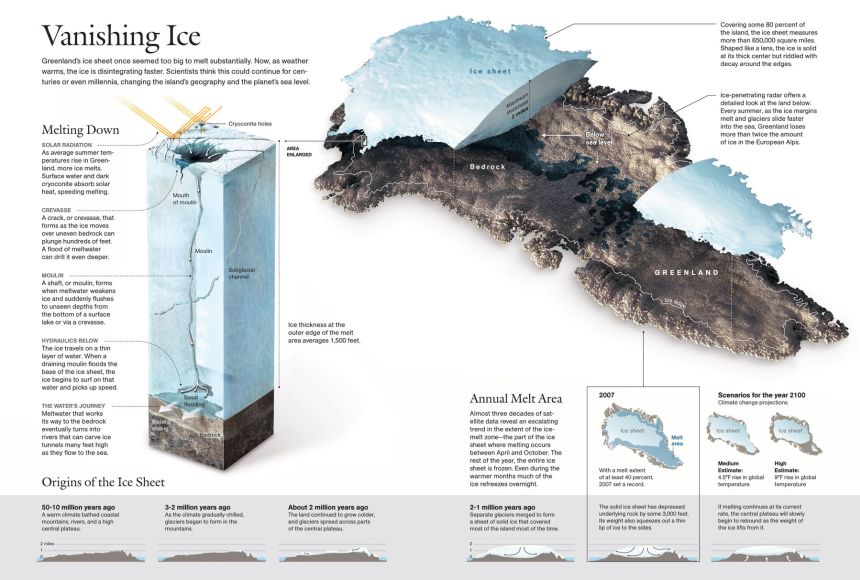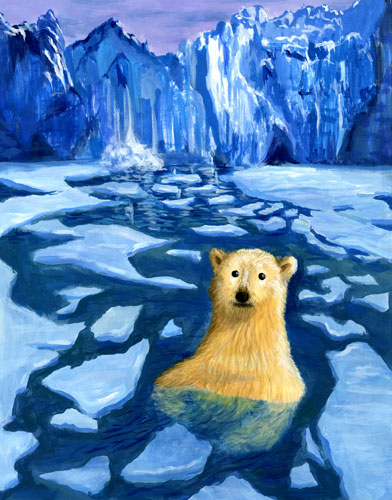 (Image/illustration found here.)
(Image/illustration found here.)
Sunshine and seemingly not-so-chilled wind this Wednesday afternoon here in California’s Central Valley — a respite from the cold rain and fog we’ve been experiencing the last month of so.
Despite the calendar time gap, I’m ready/wanting some heat.
And in connection with the word, ‘heat,’ today another piece-of-shit climate-change news, and another indication the climate is changing quicker/faster than anticipated — according to a new study published today in Nature, Greenland seems to be losing 30 million tons of ice an hour, and the future doesn’t look good.
A conclusion in nerd terms from the study’s Abstract: ‘We find that multidecadal retreat is highly correlated with the magnitude of seasonal advance and retreat of each glacier, meaning that terminus-position variability on seasonal timescales can serve as an indicator of glacier sensitivity to longer-term climate change.‘
Yikes! WTF:
A new NASA study finds that the Greenland Ice Sheet lost more ice in the past four decades than previously estimated. The majority of glaciers on the landmass have retreated significantly, and icebergs are falling into the ocean at an accelerating rate. https://t.co/3lPocNTFug pic.twitter.com/LhVDqJNLjN
— NASA Climate (@NASAClimate) January 17, 2024
Details in normal jargon via The Washington Post this afternoon:
The Greenland ice sheet has lost 20 percent more ice than scientists previously thought, posing potential problems for ocean circulation patterns and sea level rise, according to a new study.
Researchers had previously estimated that the Greenland ice sheet lost about 5,000 gigatons of ice in recent decades, enough to cover Texas in a sheet 26 feet high. The new estimate adds 1,000 gigatons to that period, the equivalent of piling about five more feet of ice on top of that fictitious Texas-sized sheet.
[…]
Glaciers can lose ice in many ways. One change can happen when large ice chunks break off at the edge, known as calving. They can also lose ice when it melts faster than it can form, causing the end of a glacier to retreat and move to higher elevations.
Scientists found that a total of 1,034 gigatons of ice was lost across all glaciers because of this retreat and calving on their peripheries. The loss accelerated since January 2000, with the glaciers losing a total of 42 gigatons each year. It has shown no signs of slowing down.
Most striking, nearly every glacier was shrinking — and in every corner of the ice sheet.
“This is a signal that’s touching every part of Greenland,” said Chad Greene, the study’s lead author and a scientist at NASA’s Jet Propulsion Laboratory. “There’s basically no part of Greenland that’s safe from climate change.”
One terrible consequential impact here is the Atlantic meridional overturning circulation (Amoc), an important component of the Earth’s climate system, a control on the flow of ocean water. This is some heavy-duty shit here.
Further from the Guardian this morning:
The Amoc was already known to be at its weakest in 1,600 years and in 2021 researchers spotted warning signs of a tipping point. A recent study suggested the collapse could happen as soon as 2025 in the worst-case scenario. A significant part of the Greenland ice sheet itself is also thought by scientists to be close to a tipping point of irreversible melting, with ice equivalent to 1-2 metres of sea level rise probably already expected.
The study, published in the journal Nature, used artificial intelligence techniques to map more than 235,000 glacier end positions over the 38-year period, at a resolution of 120 metres. This showed the Greenland ice sheet had lost an area of about 5,000 sq km of ice at its margins since 1985, equivalent to a trillion tonnes of ice.
The most recent update from a project that collates all the other measurements of Greenland’s ice found that 221bn tonnes of ice had been lost every year since 2003. The new study adds another 43bn tonnes a year, making the total loss about 30m tonnes an hour on average.
The scientists said: “There is some concern that any small source of freshwater may serve as a ‘tipping point’ that could trigger a full-scale collapse of the Amoc, disrupting global weather patterns, ecosystems and global food security. Yet freshwater from the glacier retreat of Greenland is not included in oceanographic models at present.” The influx of less dense freshwater into the sea slows the usual process of heavier salty water sinking in the polar region and driving the Amoc.
Prof Tim Lenton, at the University of Exeter, UK, and not part of the study, said: “This additional freshwater input to the north Atlantic is a concern, particularly for the formation of deep water in the Labrador and Irminger Seas within the subpolar gyre, as other evidence suggests these are the regions most prone to being tipped into an ‘off’, or collapsed state.”
“That would be like a partial Amoc collapse, but unfolding faster and having profound impacts on the UK, western Europe, parts of North America, and the Sahel region, where the west African monsoon could be severely disrupted,” he said. “Whether this previously unaccounted source is enough freshwater to make a difference depends on how close we are to that subpolar gyre tipping point. Recent models suggest it could be close already at the present level of global warming.”
[…]
The glaciers analysed in the study were mostly below sea level already, so the lost ice was replaced by sea water and did not affect sea level directly. But Greene said: “It almost certainly has an indirect effect, by allowing glaciers to speed up. These narrow fjords are the bottleneck, so if you start carving away at the edges of the ice, it’s like removing the plug in the drain.”
Greene also worked in some culture, too (Phys.org): ‘“Nearly every glacier in Greenland has thinned or retreated over the past few decades … There really aren’t any exceptions, and this is happening everywhere, all at once.”‘
Still doesn’t make it easier to digest.
Freeze in the heat, or not, yet here we are once again…
 (Illustration out front found here.)
(Illustration out front found here.)